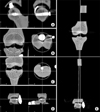This article has been retracted. See "Retraction: Comparison of Accuracy of Navigation between Infrared Optical and Electromagnetic Systems" in Volume 49 on page 496.
Abstract
Purpose
This study compared the accuracy of mechanical axis measurement between infrared optical and electromagnetic navigation.
Materials and Methods
We compared the preoperative mechanical axes of 20 TKAs using both navigation systems. Experimentally, the mechanical axes of the synthetic bone model were compared and the true mechanical axis was determined using the ORTHODOC. Additionally, a surgeon intentionally registered incorrect landmarks and then measured the amount of mechanical axis change in the two navigation methods.
Results
Clinically, AxiEM provided greater varus (10.25°±5.10°) than Orthopilot (9.02°±5.18°). The mean mechanical axis difference was 1.23° and a difference greater than 3° in the same patient occurred in 15% of patients. For the synthetic bone, the true mechanical axis was varus 1.25°, OrthoPilot displayed varus 1.10°±0.64° and AxiEM varus 1.78°±0.79°. The mechanical axis differences were not significantly different, but OrthoPilot had more reproducibility. When anatomical landmarks were erroneously identified, AxiEM showed a greater change in the mechanical axis.
Conclusion
Both navigation systems provided high mechanical axis accuracy and reproducibility under experimental conditions. Infrared optical navigation was more reproducible than electromagnetic navigation. In the clinical setting, there was a disparity of mechanical axis difference greater than 3° in 15% between the two navigation methods in the same patient.
Figures and Tables
Fig. 1
Synthetic bone models. The hip, knee and ankle joint are made of titanium which have no effect on electromagnetic field and the knee joint is constrained not allowing varus or valgus motion.

Fig. 2
(A-E) Proceeding of ORTHODOC system: (A) Femoral head center, (B) Center of distal femur, (C) Center of proximal tibia, (D) Ankle center, and (E) Measurement of mechanical axis.

Fig. 3
(A-C) Erroneous identification of anatomical landmarks: (A) Distal femur, (B) Proximal tibia, and (C) Ankle.

Fig. 4
Results of mechanical axis evaluation using Orthopilot and AxiEM navigation system. Orthopilot read mechanical axis as 0, 1, 2° varus and AxiEM did 0 to 3° varus. Orthopilot showed more reproducibility. Both navigations demonstrated 1 or 2° varus in 86%. But, this study revealed two systems could make 3° of mechanical axis difference in the worst scenario. MA, mechanical axis; EM, Electromagnetic navigation; -, negative symbol indicates varus.

Table 1
Preoperative Mechanical Axis of TKA Patients Preoperatively Determined Using Both Navigation Systems

References
1. Amin DV, Kanade T, DiGioia AM 3rd, Jaramaz B. Ultrasound registration of the bone surface for surgical navigation. Comput Aided Surg. 2003. 8:1–16.

2. Anderson KC, Buehler KC, Markel DC. Computer assisted navigation in total knee arthroplasty: comparison with conventional methods. J Arthroplasty. 2005. 20(7):Suppl 3. S132–S138.
3. Bäthis H, Perlick L, Tingart M, Lüring C, Zurakowski D, Grifka J. Alignment in total knee arthroplasty. A comparison of computer-assisted surgery with the conventional technique. J Bone Joint Surg Br. 2004. 86:682–687.
4. Bolognesi M, Hofmann A. Computer navigation versus standard instrumentation for TKA: a single-surgeon experience. Clin Orthop Relat Res. 2005. 440:162–169.
5. Chen TK, Abolmaesumi P, Pichora DR, Ellis RE. A system for ultrasound-guided computer-assisted orthopaedic surgery. Comput Aided Surg. 2005. 10:281–292.

6. Huitema RB, Hof AL, Postema K. Ultrasonic motion analysis system-measurement of temporal and spatial gait parameters. J Biomech. 2002. 35:837–842.

7. Hummel J, Figl M, Birkfelner W, et al. Evaluation of a new electromagnetic tracking system using a standarized assessment protocol. Phys Med Biol. 2006. 51:205–210.
8. Jenny JY, Boeri C, Picard F, Leitner F. Reproducibility of intra-operative measurement of the mechanical axes of the lower limb during total knee replacement with a non-image-based navigation system. Comput Aided Surg. 2004. 9:161–165.

9. Jenny JY, Clemens U, Kohler S, Kiefer H, Konermann W, Miehlke RK. Consistency of implantation of a total knee arthroplasty with a non-image-based navigation system: a case-control study of 235 cases compared with 235 conventionally implanted prostheses. J Arthroplasty. 2005. 20:832–839.
10. Khadem R, Yeh CC, Sadeghi-Tehrani M, et al. Comparative tracking error analysis of five different optical tracking systems. Comput Aided Surg. 2000. 5:98–107.

11. Lionberger R. Stiehl JB, Konermann W, Hacker R, editors. The attraction of electromagnetic computer-assisted navigation in orthopaedic surgery. Navigation and MIS in orthopaedic surgery. 2006. Heidelberg, Germany: Springer Verlag;44–53.

12. Maculé-Beneyto F, Hernández-Vaquero D, Segur-Vilalta JM, et al. Navigation in total knee arthroplsty. A multicenter study. Int Orthop. 2006. 30:536–540.
13. Pitto RP, Graydon AJ, Bradley L, Malak SF, Walker CG, Anderson IA. Accuracy of computer-assisted navigation system for total knee replacement. J Bone Joint Surg Br. 2006. 88:601–605.
14. Poulin F, Amiot LP. Interference during the use of an electromagnetic tracking system under OR conditions. J Biomech. 2002. 35:733–737.

15. Rosenow JM, Sootsman WK. Application accuracy of an electromagnetic field-based image-guided navigation system. Stereotact Funct Neurosurg. 2007. 85:75–81.

16. Saragaglia D, Picard F, Chaussard C, Montbarbon E, Leitner F, Cinquin P. Computer-assisted knee arthroplasty: comparison with a conventional procedure. Results of 50 cases in a prospective randomized study. Rev Chir Orthop Reparatrice Appar Mot. 2001. 87:18–28.
17. Schicho K, Figl M, Donat M, et al. Stability of miniature electromagnetic tracking systems. Phys Med Biol. 2005. 50:2089–2098.

18. Stiehl JB, Heck DA. Six sigma analysis of computer-assisted surgery tracking protocols in TKA. Clin Orthop Relat Res. 2007. 464:105–110.

19. Stöckl B, Nogler M, Rosiek R, Fischer M, Krismer M, Kessler O. Navigation improves accuracy of rotational alignment in total knee arthroplasty. Clin Orthop Relat Res. 2004. 26:180–186.
20. Stulberg SD, Loan P, Sarin V. Computer-assisted navigation in total knee replacement: results of an initial experience in thirty-five patients. J Bone Joint Surg Am. 2002. 84:Suppl 2. S90–S98.
21. Yau WP, Leung A, Chiu KY, Tang WM, Ng TP. Intraobserver errors in obtaining visually selected anatomic landmarks during registration process in nonimage-based navigation-assisted total knee arthroplasty: a cadaveric experiment. J Arthroplasty. 2005. 20:591–601.






